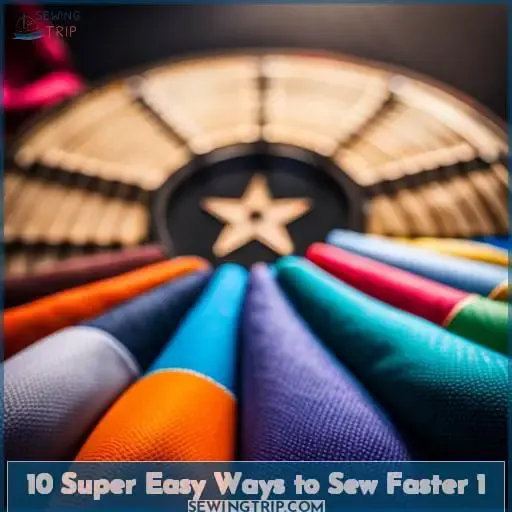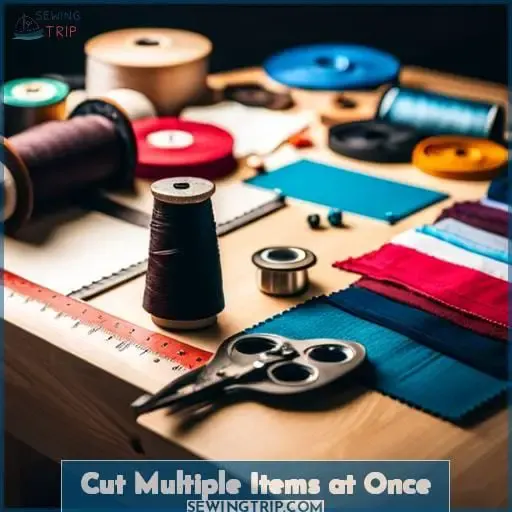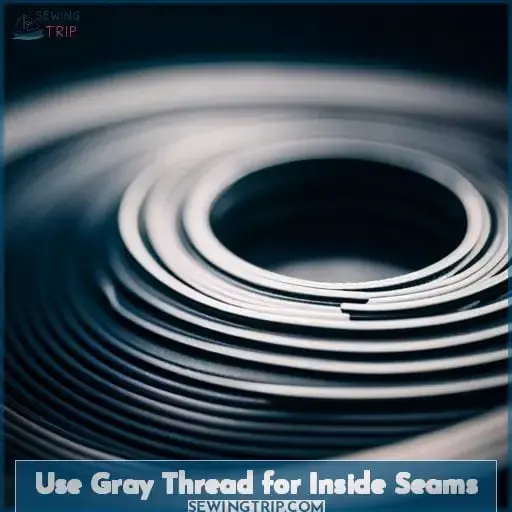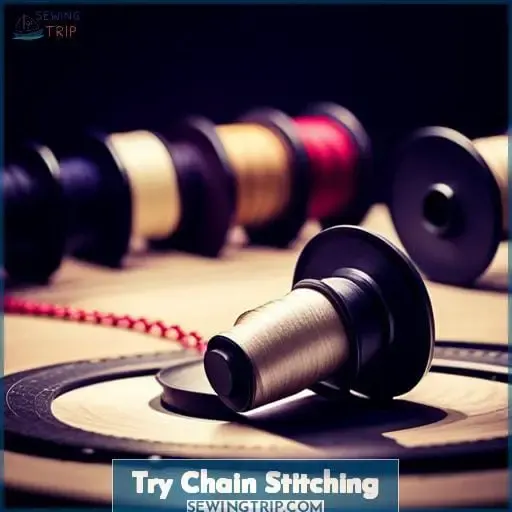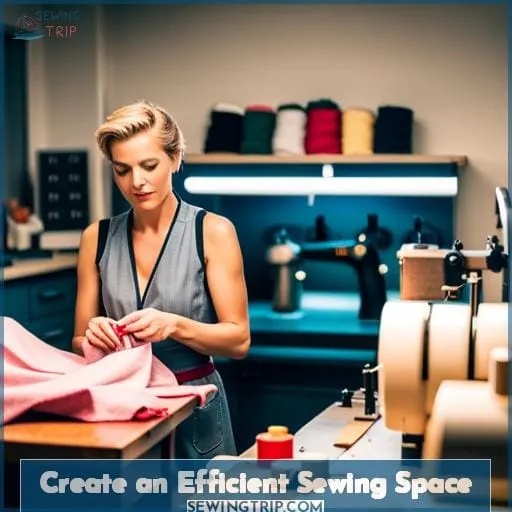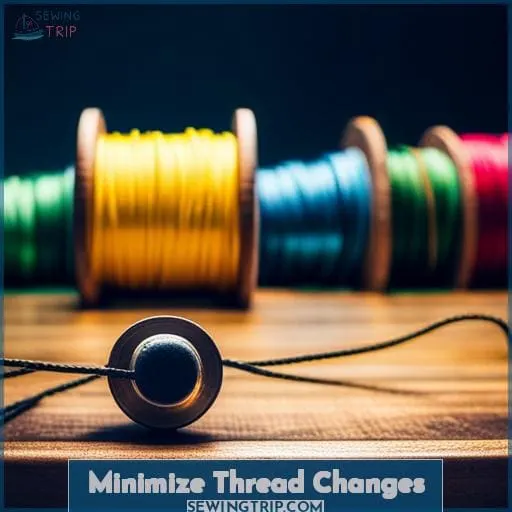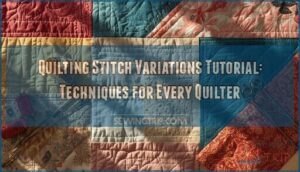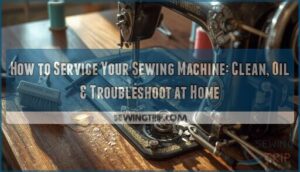This site is supported by our readers. We may earn a commission, at no cost to you, if you purchase through links.
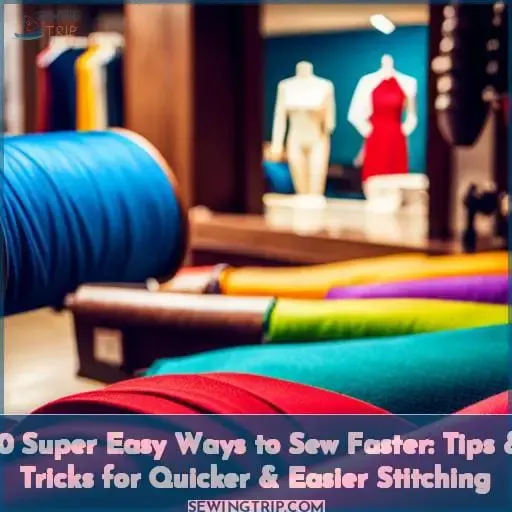
Table Of Contents
- Key Takeaways
- Organize Fabrics and Patterns
- Cut Multiple Items at Once
- Use Pins or Clips Sparingly
- Group Sewing Tasks
- Use Gray Thread for Inside Seams
- Try Chain Stitching
- Use Flat Construction Methods
- Create an Efficient Sewing Space
- Utilize a Kneebar
- Minimize Thread Changes
- Frequently Asked Questions (FAQs)
- Conclusion
Key Takeaways
- Organize fabrics and patterns before starting a project.
- Cut multiple items at once to save time.
- Use gray thread for inside seams to save time on color-matching.
- Try chain stitching to minimize thread changes.
Organize Fabrics and Patterns
Organizing your fabrics and patterns before starting a project can save you time and energy in the long run. Familiarize yourself with construction methods, pattern instructions, pre-wind bobbins, and keep sewing tools in good working order for efficiency.
Select fabric that suits your needs – color coordinate if needed – then store it correctly to avoid wrinkles or creases.
Cut multiple items at once when possible. Use fewer pins or clips to hold pieces together while cutting out raw edges faster on a cover stitch machine! If you have an extensive fabric collection, consider grouping them into collections by fiber content, weight, or color so they’re easier for selection purposes.
Taking these steps will help reduce wasted time during sewing sessions as well as minimize thread changes, which ultimately leads to better results!
Cut Multiple Items at Once
Cutting multiple items at once can save you a lot of time, so use fewer pins or clips to hold pieces together while cutting out raw edges faster on a cover stitch machine!
When selecting fabrics for your project, consider fiber content, weight, and color.
The right sides should always be facing each other when sewing pattern pieces with seam allowances.
To speed up the process even more, use pinking shears or bias tape makers to finish raw edges quickly.
A rotary cutter and cutting table are also great tools for accurately measuring and trimming fabric in one pass without having to pin everything down first!
Flat construction methods allow you to sew through several layers all at once, which reduces movement between stitches as well as thread changes, making it much faster than traditional techniques that require flipping over fabric after every few passes of stitching.
Wonder clips help keep things from shifting around during flat construction and make sure seams match perfectly before pressing with an iron-on setting if needed!
Use Pins or Clips Sparingly
Using pins or clips sparingly can help you sew faster. They’re great for temporarily holding pieces together, but too many will slow down the process. Pin placement is important to consider when sewing, as it could determine how smoothly and quickly your project goes.
Selecting the right fabric choice is also key. Look at fiber content, weight, and color before starting. Thread type should also be taken into account. Using gray thread blends well with most fabrics, while chain stitching reduces the need to trim threads after each seam.
Marking lines are essential for accuracy, so use a light-colored pencil or marker that won’t show up on darker fabrics! Sewing tools such as scissors and rulers should be kept close by in an accessible spot where they’re easy to reach during construction time.
A pin girl can make placing pins easier (and more fun!). Plus, small details like this show extra care was put into making your garment look professional, which speaks volumes about who you are as a sewer!
Finally, take advantage of all the features on modern machines like presser feet control and knee bar.
Use pins or clips sparingly throughout every step of your sewing journey: from cutting out pieces all through completion.
Group Sewing Tasks
Grouping sewing tasks together can help you save time and keep your projects organized, so try focusing on one task at a time instead of jumping around.
Preparing fabric ahead of time is key for efficient sewing. Selecting the right thread type and pattern selection will also impact how quickly you get through a project!
If possible, use flat construction methods, which are faster than traditional techniques like shoulder seams.
Another great way to maximize efficiency is by investing in presser feet that will allow for quick changes between different operations, such as zigzag stitching or buttonholes.
To further increase productivity, try utilizing smaller tricks like leaving seam allowances unfinished when fabrics don’t fray or using pinking shears to cut notches faster.
Use Gray Thread for Inside Seams
Now that you’ve got your sewing tasks grouped together and assembly line setup ready to go, it’s time to get down to the nitty-gritty of completing those projects as quickly and efficiently as possible.
One trick that can save you a lot of time is using gray thread for your interior seams. Gray blends well with most fabrics, so there’s no need for color-matching threads when hand sewing or using machines.
When finishing raw edges on knit fabric or other materials prone to fraying, consider investing in a serger machine.
Using gray thread may require some extra effort up front, but it surely pays off in terms of faster sewing overall.
Try Chain Stitching
Try chain stitching for your interior seams to minimize thread changes and reduce the amount of time spent winding bobbins! Chain stitching is a great way to speed up the sewing process. It involves using one continuous piece of thread that goes through several stitches, eliminating the need for cutting and re-threading as you go.
To achieve optimal results when chain stitching, it’s important to pay attention to thread selection, stitch length setting, pressure adjustment on the presser foot or knee bar (depending on the machine type used), seam placement accuracy, and fabric choice.
You can also use different feet, such as a zipper foot or cording foot, which are suitable for certain fabrics already in place so you don’t have to change them mid-project.
Additionally, watching related tutorials about fast sewing techniques will help enhance efficiency too.
Use Flat Construction Methods
You can accelerate your sewing process by utilizing flat construction methods. This involves laying pattern pieces on top of each other and stitching in one go, avoiding the need for assembling individual parts.
Choosing fabrics that are suitable for flat construction is important— lightweight, non-fraying materials like cottons or silks work best.
Furthermore, setting up an assembly line with a rolling chair next to your machines ensures you don’t waste precious seconds reaching back and forth between them.
Create an Efficient Sewing Space
Creating a comfortable, clutter-free workspace is critical for crafting efficient sewing projects. When it comes to space efficiency and time management, there are several things you can do.
Here’s a list of tips to help organize your sewing room:
- Room Layout: Strategize the layout of your workspace with plenty of breathing room between machines and tools. Place an ironing board or tabletop ironing board near where you sew so that pressing gets done quickly when needed during the project process.
- Sewing Supplies: Storing supplies close by will save time—organizing fabric stash into colors or weights makes selecting just what’s needed much easier! Utilize wall organizers for thread spools, scissors, pins, etc.
- Space Organization: A good thing about small spaces is they force us to stay organized! Allocate specific areas for each step in the sewing process such as cutting out patterns or construction – this way everything has its place and nothing goes missing mid-project.
With these tips plus free sewing patterns from online resources like Craftsy & Coats & Clark at your fingertips, you’ll be ready to conquer any holiday rush while creating awesome gifts too!
Utilize a Kneebar
Utilizing a kneebar can help you sew faster, saving time and energy. A kneebar is an adjustable bar that attaches to the side of your sewing machine, allowing for much pressing with ease when handling long or large pieces of fabric without having to use both hands.
This makes it easier to handle those whole piles of fabric quickly during holiday rushes.
Setting up a kneebar correctly is important so that it does not interfere with any other processes, such as using the foot pedal or changing needle settings.
Taking advantage of all these advantages offered by the right setup can considerably increase efficiency. Making sure you have everything ready before starting will also save time in searching through drawers, which would otherwise be wasted seconds adding up over multiple projects.
Minimize Thread Changes
Making sure you’re minimizing thread changes when sewing is key for getting projects done faster. Thread tension, quality of the thread, and type of seam are all factors that should be taken into consideration before starting any project.
Make sure to choose a needle size that is appropriate for your fabric and use high-quality threads in colors that will blend well with the material you’re using.
When cutting pattern pieces, it’s best to cut multiple sizes at once if possible.
Additionally, consider using patterns which include bias binding foot options. This can be one of the biggest time savers available.
By taking these small steps now during preparation stages prior to sewing, a project quickly becomes more achievable than ever before!
Frequently Asked Questions (FAQs)
What type of fabric should I use for faster sewing?
Choose fabrics that are lightweight, don’t fray easily, and are easy to work with. Opt for cottons or blends with smooth textures rather than thick weaves. Utilizing pre-cut shapes, such as bias tape makers and fabric glue, can also help save time.
How do I use a bias tape maker to speed up sewing?
Using a bias tape maker is an efficient way to add fast, professional details to your projects. Plus, with its adjustable settings, you can create custom widths for various fabrics and styles.
How can I make sure I don’t make mistakes when chain stitching?
To avoid mistakes when chain stitching, make sure to practice beforehand. Use a contrasting thread for better visibility and slow down your speed until you feel confident with the stitch. It’s worth taking the extra time! This technique may seem intimidating, but once mastered, it can lead to beautiful results, saving you time and effort in the long run.
What type of lighting is best for sewing?
Bright, natural light is best for sewing. You’ll have more visibility and accuracy while avoiding eyestrain to ensure precision with every stitch.
How do I use a serger for finishing raw edges?
To use a serger for finishing raw edges, thread it with two spools of contrast-colored thread and adjust the tension. Turn your fabric over, then trim and stitch in one step – creating perfect seams that won’t fray! Experiment to find the ideal settings for your project.
Conclusion
Concluding, sewing faster is a skill that requires practice and dedication to master. With the right tips and tricks, anyone can become a speed demon. From organizing fabrics and patterns to utilizing a knee bar, these ten simple steps can help anyone sew faster and more efficiently.

